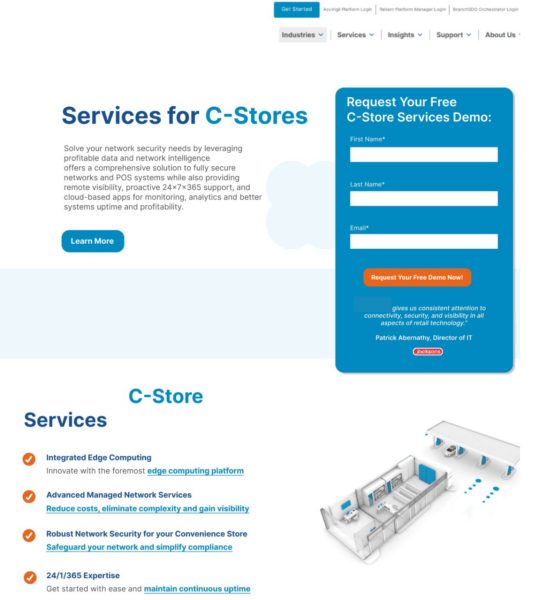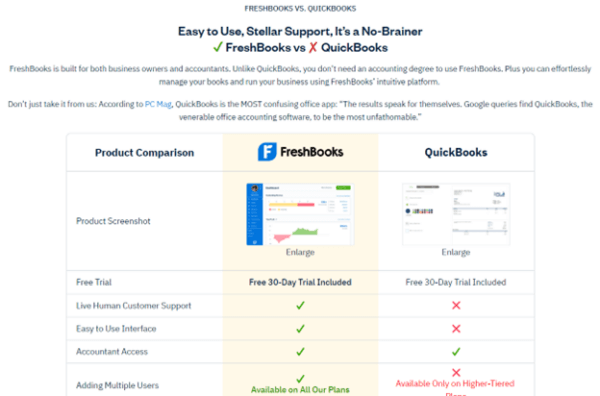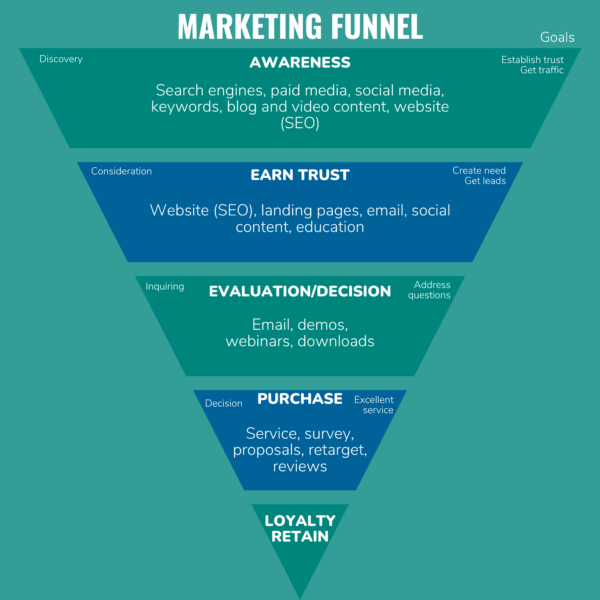Let’s face it. Digital marketing for B2C E-commerce is more straightforward than B2B marketing.
With B2C, depending on average order value and number of channels, actions can be tied directly to revenue in a relatively short time which lets B2C marketers quickly analyze data, implement changes, and pivot when desired.
Why B2B Marketing is Particularly Difficult
Running digital marketing for B2B is one of the most challenging undertakings for a marketer.
There are a lot of reasons why that’s the case. Here are some of them:
- Finding and fine-tuning the right balance between reach and targeted audience takes a lot of trial and error
- B2B, especially SaaS, often offers new solutions that aren’t yet known to its target audience or are very niche and in those cases online search volume is limited, making B2B SaaS marketing services unique
- B2B keywords’ CPCs are more expensive. Have you tried looking at Google CPC estimates for keywords containing “software” or “platform”?
- B2B typically has a higher price point and usually the higher the price point the longer the sales cycle
- B2B typically has multiple decision makers and influencers that impact the eventual sale
- These decision makers and influencers rely heavily on more sources of information than only digital marketing (in many times word of mouth)
- The B2B sales cycle generally has multiple steps and touch points before a sale happens, from first engagement with the brand (PPC, organic, social) to lead submission to sales person
- The multiple steps result in a long time lag betweenB2B marketing efforts and the associated revenue
- The B2B marketing tech is often more complex than e-commerce and sometimes those multiple tech layers make marketing more expensive
But for our (un)Common Logic team, difficult just means an exciting challenge to overcome.
Let’s dive into the first things we look at when working with a client to put together a B2B digital marketing strategy.
How is the Brand’s Website Supporting or Contributing to Marketing Efforts?
In many cases, the main B2B marketing goal is to receive leads, which are often requests for demos. That is completely understandable. Prospects requesting demos are likely further down the buying funnel which means there is a higher likelihood to convert and as a result generate a high ROI.
But the biggest mistake we’ve seen is to make leads and demo requests the sole purpose of the site. This can be identified easily by reviewing the site and analytics. Here are some examples:
- PPC landing pages
- Do they provide enough content?
- Is the form fill the only valuable entity on the page?
- Did the landing page remove all exit points?
- Are all paid digital marketing campaigns leading to the same/similar pages?
- What is the bounce rate?
- How long do visitors stay on site after landing on site?
- How many pages do they engage with?
- Other site pages
- Is the content on-site engaging for every decision maker to help them as they move through the buying funnel?
- Is the site navigation intuitive and easy to use to encourage longer time on the site and multiple page views?
When a brand focuses only on generating leads, there is a tremendous potential loss of quality audiences and a very high percentage of advertising dollars wasted.
Why should the site treat every visitor the same when you are engaging in different marketing initiatives (from search brand to search prospecting to competitor bidding or display)?
Here are some examples of pages on the site that can address and align with different types of audiences:
When a prospect first visits a website, they often don’t yet know much about the company’s product or service so they need an easy-to-understand explanation of what the company does. For example, one of our clients provides computer networking and security solutions to convenience stores:

Once a prospect is getting closer to being ready to buy, having a page which helps them decide between your company and a competitor can have a significant impact. Below is a screenshot of part of the page where FreshBooks provided more information to that audience:

After a prospect has learned about the company, what it has to offer, and how making a purchase will benefit them, it’s important to make that next step easy, the way Kinsta does:

While the brand’s website is one of the most important sources of information for any potential customer, the website cannot be the end-all be-all of engagement with audiences.
One of the reasons for this is walled gardens. Third-party cookie deprecation and legislation issues over privacy are creating data gaps for Google, Meta, Microsoft etc. which are disincentivizing platforms to send traffic to sites. This, alongside advancements in utilizing AI, is resulting in the gradual decrease of site traffic as platforms are scraping information from different sources (sites, social).
To continue supporting growth, a business must engage with its audiences across different platforms including both search engines and all relevant social media platforms.
Is the Entire Buying Funnel and Diversification of Channels Taken into Account?
The next place that we see mistakes is when executives or decision-makers compare the performance of audiences at different points in the funnel and expect the same cost per acquisition. Associated with this is often a lack of tolerance for testing and varying lead quality at different points in the funnel. This is especially true for paid activities.
Typically, a business will use PPC to target:
- Prospecting audiences on social, display, and video via Google, YouTube, Meta, LinkedIn, programmatic platforms, etc.
- Prospecting audiences on search engines like Google and Microsoft
- Remarketing to target past site visitors
- Brand searches on Google and Microsoft
The problems arise when reporting show, as expected, that branded activities and remarketing provide the best return on advertising spend. The wrong assumption is to then decide to cut all other spend. This, of course, will have a negative impact on growth long term.
By targeting only the bottom part of the funnel, marketing will not only miss a big portion of decision makers, it will also miss being the first to educate and help audiences that have not yet identified their pain and need.
Instead, the right course of action is to ensure paid activities are structured to provide insights and levers alongside designing incrementality tests. In future articles in this series we’ll dive deeper on the right media mix for B2B and how to design incrementality tests.
What is the Overall Plan of Engagement With Your Brand?
Ultimately, adding the valuable content to the site and planning a diverse well-thought out media mix meet goals only when they work together.
Delivering the right content to the right audience at the right time and place will shepherd a business decision to the brand.
This is why the content makers and the paid digital team must have a waterfall plan to remove as much friction as possible for the audience.

Site, social channels, and paid media are one part of a well-oiled machine to educate prospective clients and gather their first party data for the sales team; however, to truly close the loop to the final sale, the business must create a cohesive link between the marketing and sales teams with the help of the right marketing technology and the correct reporting mapping. More on this in our next article.
Contact us to talk about how our approach to B2B digital marketing can help achieve your business goals.
Let’s face it. Digital marketing for B2C E-commerce is more straightforward than B2B marketing.
With B2C, depending on average order value and number of channels, actions can be tied directly to revenue in a relatively short time which lets B2C marketers quickly analyze data, implement changes, and pivot when desired.
Why B2B Marketing is Particularly Difficult
Running digital marketing for B2B is one of the most challenging undertakings for a marketer.
There are a lot of reasons why that’s the case. Here are some of them:
- Finding and fine-tuning the right balance between reach and targeted audience takes a lot of trial and error
- B2B, especially SaaS, often offers new solutions that aren't yet known to its target audience or are very niche and in those cases online search volume is limited, making B2B SaaS marketing services unique
- B2B keywords’ CPCs are more expensive. Have you tried looking at Google CPC estimates for keywords containing “software” or “platform”?
- B2B typically has a higher price point and usually the higher the price point the longer the sales cycle
- B2B typically has multiple decision makers and influencers that impact the eventual sale
- These decision makers and influencers rely heavily on more sources of information than only digital marketing (in many times word of mouth)
- The B2B sales cycle generally has multiple steps and touch points before a sale happens, from first engagement with the brand (PPC, organic, social) to lead submission to sales person
- The multiple steps result in a long time lag betweenB2B marketing efforts and the associated revenue
- The B2B marketing tech is often more complex than e-commerce and sometimes those multiple tech layers make marketing more expensive
But for our (un)Common Logic team, difficult just means an exciting challenge to overcome.
Let’s dive into the first things we look at when working with a client to put together a B2B digital marketing strategy.
How is the Brand's Website Supporting or Contributing to Marketing Efforts?
In many cases, the main B2B marketing goal is to receive leads, which are often requests for demos. That is completely understandable. Prospects requesting demos are likely further down the buying funnel which means there is a higher likelihood to convert and as a result generate a high ROI.
But the biggest mistake we’ve seen is to make leads and demo requests the sole purpose of the site. This can be identified easily by reviewing the site and analytics. Here are some examples:
- PPC landing pages
- Do they provide enough content?
- Is the form fill the only valuable entity on the page?
- Did the landing page remove all exit points?
- Are all paid digital marketing campaigns leading to the same/similar pages?
- What is the bounce rate?
- How long do visitors stay on site after landing on site?
- How many pages do they engage with?
- Other site pages
- Is the content on-site engaging for every decision maker to help them as they move through the buying funnel?
- Is the site navigation intuitive and easy to use to encourage longer time on the site and multiple page views?
When a brand focuses only on generating leads, there is a tremendous potential loss of quality audiences and a very high percentage of advertising dollars wasted.
Why should the site treat every visitor the same when you are engaging in different marketing initiatives (from search brand to search prospecting to competitor bidding or display)?
Here are some examples of pages on the site that can address and align with different types of audiences:
When a prospect first visits a website, they often don’t yet know much about the company’s product or service so they need an easy-to-understand explanation of what the company does. For example, one of our clients provides computer networking and security solutions to convenience stores:

Once a prospect is getting closer to being ready to buy, having a page which helps them decide between your company and a competitor can have a significant impact. Below is a screenshot of part of the page where FreshBooks provided more information to that audience:

After a prospect has learned about the company, what it has to offer, and how making a purchase will benefit them, it’s important to make that next step easy, the way Kinsta does:

While the brand’s website is one of the most important sources of information for any potential customer, the website cannot be the end-all be-all of engagement with audiences.
One of the reasons for this is walled gardens. Third-party cookie deprecation and legislation issues over privacy are creating data gaps for Google, Meta, Microsoft etc. which are disincentivizing platforms to send traffic to sites. This, alongside advancements in utilizing AI, is resulting in the gradual decrease of site traffic as platforms are scraping information from different sources (sites, social).
To continue supporting growth, a business must engage with its audiences across different platforms including both search engines and all relevant social media platforms.
Is the Entire Buying Funnel and Diversification of Channels Taken into Account?
The next place that we see mistakes is when executives or decision-makers compare the performance of audiences at different points in the funnel and expect the same cost per acquisition. Associated with this is often a lack of tolerance for testing and varying lead quality at different points in the funnel. This is especially true for paid activities.
Typically, a business will use PPC to target:
- Prospecting audiences on social, display, and video via Google, YouTube, Meta, LinkedIn, programmatic platforms, etc.
- Prospecting audiences on search engines like Google and Microsoft
- Remarketing to target past site visitors
- Brand searches on Google and Microsoft
The problems arise when reporting show, as expected, that branded activities and remarketing provide the best return on advertising spend. The wrong assumption is to then decide to cut all other spend. This, of course, will have a negative impact on growth long term.
By targeting only the bottom part of the funnel, marketing will not only miss a big portion of decision makers, it will also miss being the first to educate and help audiences that have not yet identified their pain and need.
Instead, the right course of action is to ensure paid activities are structured to provide insights and levers alongside designing incrementality tests. In future articles in this series we’ll dive deeper on the right media mix for B2B and how to design incrementality tests.
What is the Overall Plan of Engagement With Your Brand?
Ultimately, adding the valuable content to the site and planning a diverse well-thought out media mix meet goals only when they work together.
Delivering the right content to the right audience at the right time and place will shepherd a business decision to the brand.
This is why the content makers and the paid digital team must have a waterfall plan to remove as much friction as possible for the audience.

Site, social channels, and paid media are one part of a well-oiled machine to educate prospective clients and gather their first party data for the sales team; however, to truly close the loop to the final sale, the business must create a cohesive link between the marketing and sales teams with the help of the right marketing technology and the correct reporting mapping. More on this in our next article.
Contact us to talk about how our approach to B2B digital marketing can help achieve your business goals.

